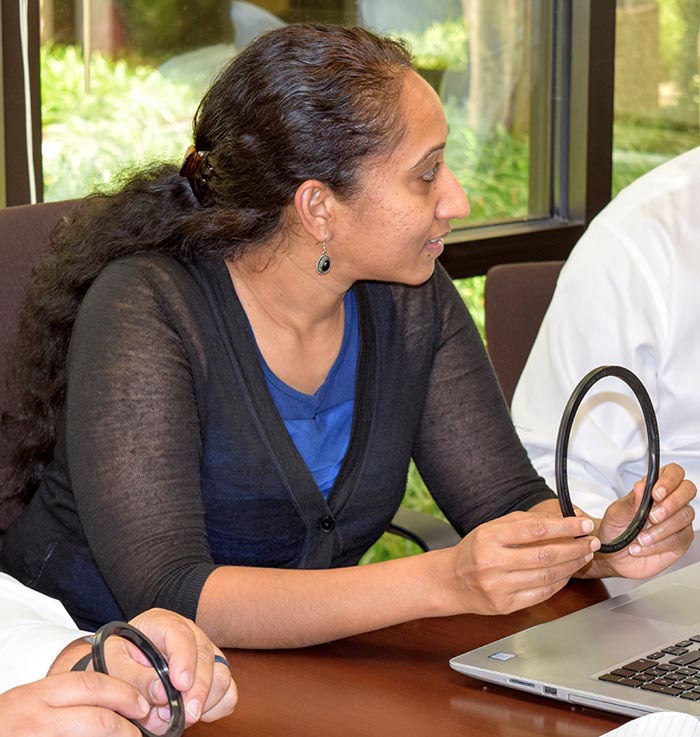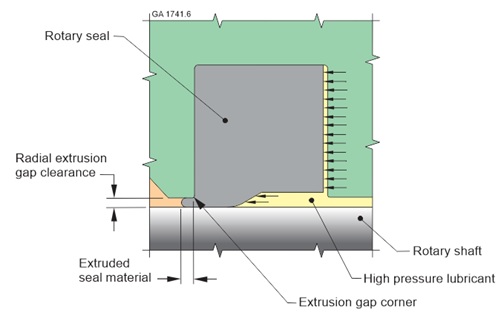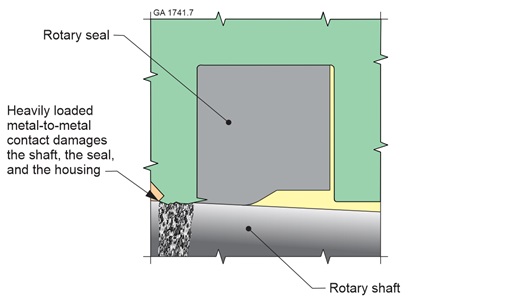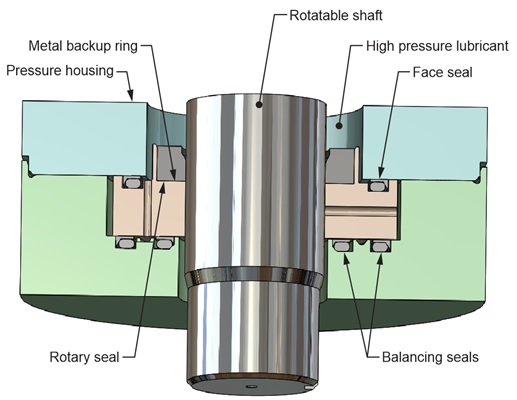Floating Backup Rings for High Pressure Rotary Sealing
Contact Us
Learn how the Kalsi Engineering floating metal backup ring technology can be applied to your high-pressure sealing application.

Introduction to our high pressure seal technology
Shaft misalignment and runout and pressure-induced component deformation are significant challenges when implementing high pressure rotary seals. Kalsi Engineering has developed a floating metal backup ring that successfully addresses these challenges with a geometry that is substantially immune to pressure-induced deformation and follows lateral shaft motion. The video above explains how it works. Customers who require the highest-pressure capacity should consider this innovative high-performance rotary shaft seal assembly. Contact Kalsi Engineering to discuss licensing options.
High Pressure Rotary Seal Implementation Challenges
As shown in Figure 1 below, a rotary seal must bridge the necessary clearance between a pressure housing and a relatively rotatable shaft. This clearance is commonly referred to as the “extrusion gap”. When pressure is applied, the extrusion gap will increase due to pressure breathing of the housing. The pressure-induced expansion of the housing also increases the fit between the housing and the shaft guidance bearings. This increases the potential for shaft runout and lateral deflection, which makes the extrusion gap larger on one side and smaller on the other side.
High pressure forces seal material into the extrusion gap. Once extruded into the gap, the extruded seal material is destroyed by the cutting action of the extrusion gap corner of the housing and the crushing action of compression changes caused by shaft runout. This type of damage is called “extrusion damage”. As extruded material is lost to extrusion damage, more seal material is fed into the gap, in a continuing damage process. The larger the extrusion gap, the worse the high pressure seal damage.
One of the biggest challenges in successfully implementing a high-pressure rotary seal is how to achieve the smallest possible extrusion gap clearance to minimize extrusion damage, while at the same time avoiding shaft runout and deflection-induced metal-to-metal contact at the extrusion gap (Figure 2). Such contact can generate enough frictional heat to significantly reduce the strength and extrusion resistance of the seal material. In extreme cases, this heat will melt the seal. Such contact can also damage critical surfaces of the shaft and housing, creating burrs and rough surfaces that cut and abrade the seal.


How the Floating Backup Ring Addresses High Pressure Rotary Seal Implementation Challenges
Our patented floating backup ring helps rotary seals achieve the highest possible operating pressure by defining the smallest possible extrusion gap. The backup ring assembly (shown in Figure 3 below and described in the video above) is used to seal between a pressure housing and a rotatable shaft to retain a high-pressure lubricant. A rotary seal is mounted in the metal backup ring. The rotary seal is compressed radially and establishes sealing between the backup ring and the shaft. The high-pressure lubricant is located between the pressure housing, the seal, and the shaft.
The bore of the metal backup ring has a very close fit with the shaft and locates the backup ring laterally. Compared to a larger clearance, this close fit is much easier for the rotary seal to bridge in high pressure conditions.
A face seal establishes sealing between the backup ring and the pressure housing. Together, the rotary seal and the face seal retain the high-pressure lubricant within the pressure housing.
The metal backup ring is located axially by a bulkhead. An inner balancing seal and an outer balancing seal establish sealing between the bulkhead and the metal backup ring. The face seal and the inner and outer balancing seals are specially designed high pressure seals.
The pressure of the lubricant acts over the sealed area defined by the rotary seal and the face seal. This produces a hydraulic force acting downward on the backup ring.
An axial hole conducts the pressure of the lubricant to the sealed region between the inner and outer balancing seals. The inner and outer balancing seals define a sealed area on the underside of the backup ring. Lubricant pressure acting over this sealed area produces a hydraulic force acting upward on the backup ring.
The upward hydraulic force and the downward hydraulic force are substantially equal. As a result, the forces counteract one another, and the net hydraulic thrust acting on the backup ring is substantially zero. This axial force balance allows the backup ring and the rotary seal to move laterally to follow shaft runout. An anti‐rotation tang prevents the backup ring from turning with the shaft. The tang is not shown in Figure 3.
We offer rotary seals that are specially designed for high pressure service. During rotation, a wavy geometry on the dynamic lip of the seal pumps a film of oil between the seal and the shaft, and into the clearance between the shaft and the backup ring. This reduces seal friction and seal-generated heat and lubricates the backup ring.
A radial hole conducts atmospheric pressure to the outside of the backup ring. Because the pressure is the same on the inside and outside of the backup ring, the backup ring is substantially free from pressure‐related diameter changes. This dimensional stability means that the clearance between the bore of the backup ring and the outer diameter of the shaft can be kept very small and stable. This small and stable clearance is ideal for the rotary seal, in terms of resisting high pressure seal damage.
There is a slight radial offset between the upward acting hydraulic force and the downward acting hydraulic force. This radial offset applies torsion to the backup ring. If not addressed, this torsion will cause cross‐sectional twisting of the backup ring that affects its fit with the shaft.
To prevent cross‐sectional twisting of the backup ring, the rotary seal is axially offset with respect to the face seal. This slight axial offset provides a slight pressure imbalance acting radially outward. This slight imbalance creates a countervailing torque that counteracts the torque caused by radial misalignment of the axial hydraulic forces. This provides the backup ring with additional dimensional stability so its fit with the shaft can be as small and stable as possible.
The resulting small clearance between the backup ring and the shaft is optimal for high-pressure rotary sealing because it reduces pressure‐related seal extrusion damage. Contact Kalsi Engineering to discuss how to implement this high pressure seal design in your equipment. Additional information is provided in our rotary shaft seal handbook.

How Our High-Pressure Rotary Shaft Seals Work
Kalsi-brand rotary shaft seals (Figure 4) are polymeric rings that establish sealing as a result of being radially compressed against the shaft. The dynamic lip that engages the shaft incorporates patented hydrodynamic waves that pump a film of lubricant between the seal and shaft in response to shaft rotation. This lubricant film reduces friction, wear, and seal generated heat. Since the strength of polymeric seal materials decreases with increasing temperature, the cooler running characteristics of our innovative rotary shaft seals helps to preserve high pressure extrusion resistance. The cooler running characteristics also allow the use of exceptionally wide sealing lips, which have more inherent strength to resist extrusion, and more sacrificial material to withstand extrusion damage-related material loss. Our highest pressure seal design has an extrusion resistant plastic liner for even more pressure capacity. Contact our staff for assistance in selecting the best high pressure seal solution for your application.


Contact Kalsi Engineering to learn how the floating metal backup ring technology can be applied to your high-pressure sealing application. For available high pressure seal sizes, see our online shaft seal catalog. Additional seal sizes can be manufactured, but may require a one time tooling charge.
